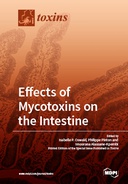Explore

Effects of Mycotoxins on the Intestine
0 Ungluers have
Faved this Work
Login to Fave
Mycotoxins are secondary metabolites produced by several fungal species. They can contaminate human food and animal feed, and have been a threat for thousands of years. The gastrointestinal tract is the first target when ingesting mycotoxin-contaminated food or feed. As unlikely as it sounds, the investigations concerning the effects of mycotoxins on the intestine are still in their early stages. This book gathers the most recent advances related to the characterization of the intestinal toxicity of mycotoxins. Substantial data assembled on the damage caused to a number of histological structures and functions of the intestine remove any remaining doubt about this organ being a primary target for the toxicity of mycotoxins. An interesting overview of the detrimental effects of mycotoxins on the gut-hosted microbiota—now regarded as a fully-fledged organ associated with the gut—is also given. Finally, outstanding contributions in this book address questions relating to the suitability of current regulations to protect against alterations of the intestine, and to the efficacy assessment of new detoxification strategies using the intestinal toxicity of mycotoxins as a relevant endpoint.
This book is included in DOAB.
Why read this book? Have your say.
You must be logged in to comment.
Rights Information
Are you the author or publisher of this work? If so, you can claim it as yours by registering as an Unglue.it rights holder.Downloads
This work has been downloaded 452 times via unglue.it ebook links.
- 154 - pdf (CC BY-NC-ND) at Unglue.it.
- 298 - pdf (CC BY-NC-ND) at res.mdpi.com.
Keywords
- aflatoxin B1
- aflatoxin M1
- atlantic salmon
- caecal water
- Claviceps
- Clostridium sp. WJ06
- colon microbiota
- contaminated feed
- deoxynivalenol
- Detoxification
- digestive tract
- doses
- enteric nervous system
- Ergot Alkaloids
- explant technique
- feed
- fumonisin
- functional oligosaccharides
- Fusarium mycotoxins
- genotoxicity
- goblet cells
- Histology
- histopathological lesions
- hydrogen-rich water
- Ileum
- Inflammation
- intestinal bacterial flora
- intestinal epithelial cells
- intestinal microbiota
- intestinal morphology
- intestine
- jejunum
- Lactobacillus
- lactulose
- large intestine
- Lipid Metabolism
- Liver
- Mice
- microbial diversity
- microbiota
- MiSeq 16S rDNA sequencing
- Mitochondrial apoptosis
- mycotoxin
- Mycotoxins
- N-acetylcysteine
- n/a
- ochratoxin A
- Oxidative Stress
- PCR
- Permeability
- pig
- Piglet
- piglets
- Pigs
- pre-pubertal gilts
- proliferating cell nuclear antigen
- Response
- Saccharomyces cerevisiae boulardii CNCM I-1079
- sclerotia
- SIEC02 cells
- small intestine
- suppressor of cytokine signaling
- Swine
- T-2 toxin
- tight junction
- Tight Junctions
- Toll-Like Receptors
- Toxicity
- transcriptome
- ultrastructural changes
- ultrastructure
- vasoactive intestinal polypeptide
- zearalenone
Links
DOI: 10.3390/books978-3-03897-783-4Editions


